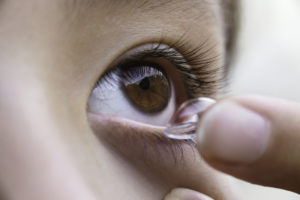July 17, 2023
By Dwight Akerman, OD, MBA, FAAO, FBCLA, FIACLE
 This study aimed to conduct a systematic review and meta-analysis of randomized controlled trials (RCTs) on the effects of orthokeratology for slowing myopia progression in children at different time points over two years.
This study aimed to conduct a systematic review and meta-analysis of randomized controlled trials (RCTs) on the effects of orthokeratology for slowing myopia progression in children at different time points over two years.
Researchers from China performed a specific search on PubMed, Embase, Cochrane Library, Clinical Trials, CNKI, SinoMed, and Wanfang Data for RCTs conducted up to Oct. 1, 2022. They pooled the weighted mean difference (WMD) between the OrthoK and control groups for axial length (AL) elongation and the odds ratio (OR) for rates of adverse events and dropout.
Seven RCTs involving 655 eyes were included. There were significant differences in the effects of OrthoK versus control in slowing AL elongation with WMD of –0.11mm at six months, –0.16mm at 12 months, –0.23mm at 18 months, and –0.28mm at 24 months. Myopia control rate declined, with 64%, 53%, 50%, and 47% recorded for six, 12, 18, and 24 months, respectively. There was no statistical significance for adverse events between OrthoK and control groups.
The researchers found that OrthoK can effectively reduce AL elongation in myopic children within six months, with a prolonged effect over 24 months. However, the axial length control rate declined over the course of the study. A subgroup analysis noted that Caucasian children received more benefits than East Asian children in 12 months, and children with high myopia received more benefits than children with low to moderate myopia in six months and 12 months.
The researchers concluded that OrthoK can effectively slow axial length progression in children, but the efficacy decreases with time.
Abstract
Orthokeratology for Slowing Myopia Progression in Children: A Systematic Review and Meta-Analysis of Randomized Controlled Trials
Kai Tang , Junkang Si, Xingrong Wang, Xiuzhen Lu, Hongsheng Bi
Objective: To conduct a systematic review and meta-analysis of randomized controlled trials (RCTs) on the effects of orthokeratology for slowing myopia progression in children.
Methods: We performed a specific search on PubMed, Embase, Cochrane Library, Clinical Trials, CNKI, SinoMed, and Wanfang Data for RCTs conducted up to October 1, 2022. We pooled the weighted mean difference (WMD) between the orthokeratology and control groups for axial length (AL) elongation and the odds ratio (OR) for rates of adverse events and dropout.
Results: Seven RCTs involving 655 eyes were included. There were significant differences in the effects of orthokeratology versus control in slowing AL elongation with WMD of -0.11 mm (95% confidence interval (CI), -0.13 to -0.08; P<0.01) at 6 months, -0.16 mm (95% CI, -0.18 to -0.13; P<0.01) at 12 months, -0.23 mm (95% CI, -0.29 to -0.18; P<0.01) at 18 months, and -0.28 mm (95% CI, -0.38 to -0.19; P<0.01) at 24 months, respectively. Myopia control rate declined, with 64%, 53%, 50%, and 47% recorded for 6, 12, 18, and 24 months, respectively. There was no statistical significance for adverse events between orthokeratology and control groups (OR=2.63, 95% CI, 0.72-9.61; P=0.11).
Conclusion: Orthokeratology can effectively slow myopia progression in children, and the efficacy of myopia control decreases with time.
Tang, K., Si, J., Wang, X., Lu, X., & Bi, H. (2022). Orthokeratology for Slowing Myopia Progression in Children: A Systematic Review and Meta-Analysis of Randomized Controlled Trials. Eye & Contact Lens, 10-1097.
DOI: 10.1097/ICL.0000000000001006













